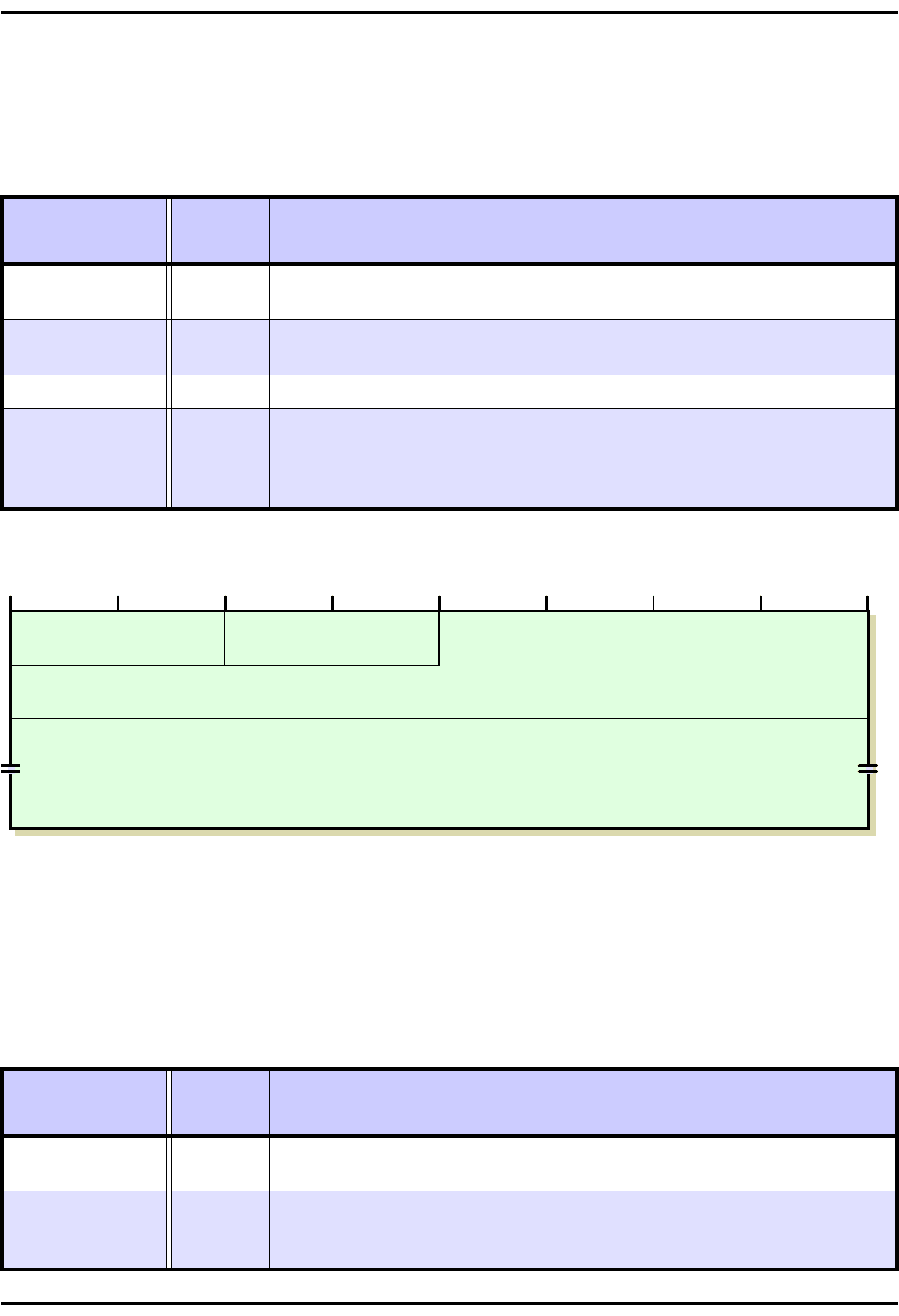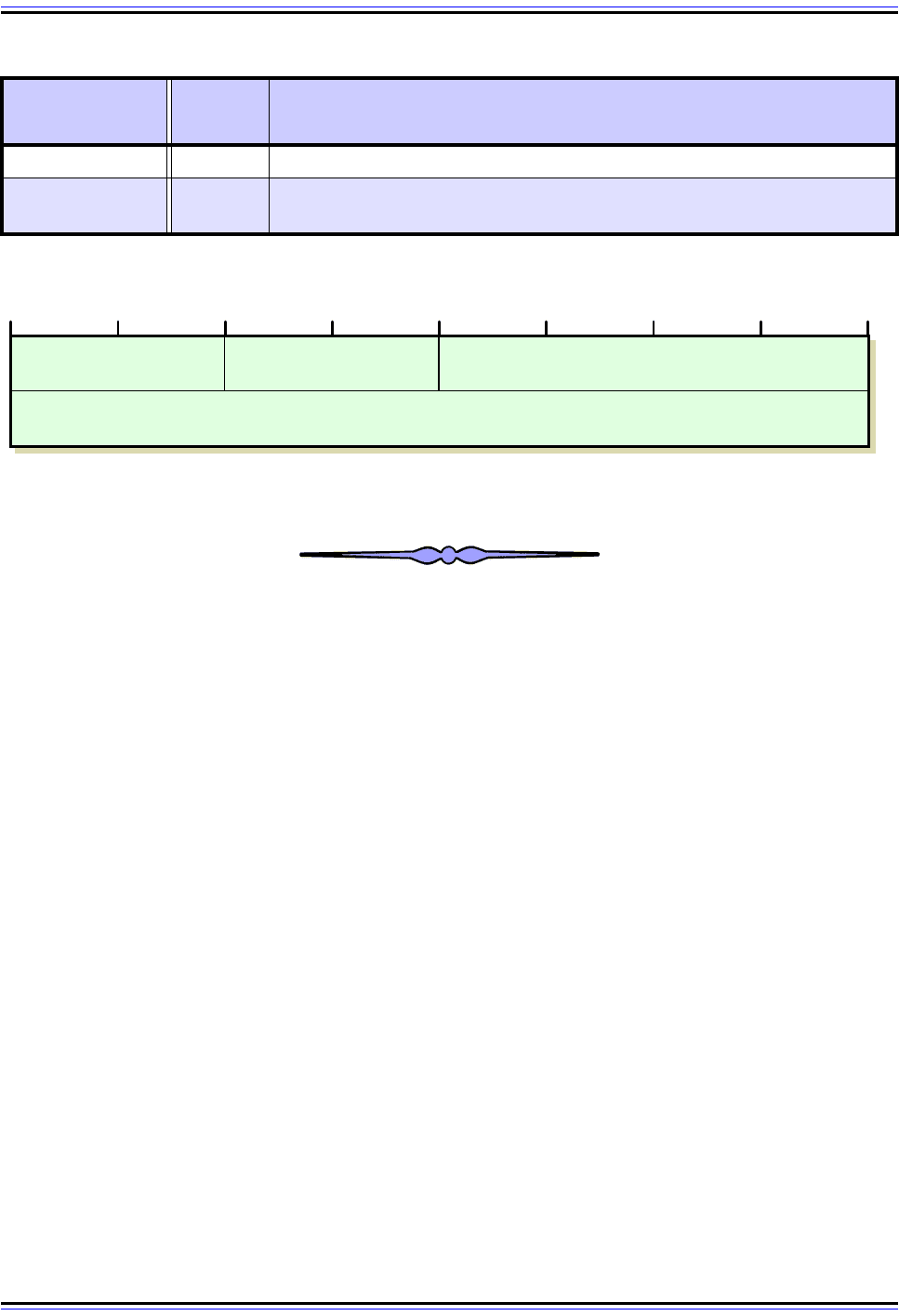Charles M. Kozierok The TCP-IP Guide
Подождите немного. Документ загружается.


The TCP/IP Guide - Version 3.0 (Contents) ` 681 _ © 2001-2005 Charles M. Kozierok. All Rights Reserved.
Redirected Header Option Format
In a Redirect message, provides a copy of the original message (or a portion of it) that led
to the Redirect being generated. This option can be found in Table 119 and Figure 167.
MTU Option Format
The MTU option lets a router convey a recommended MTU value in Router Advertisement
messages. Its format is described in Table 120 and Figure 168.
Table 119: ICMPv6 Redirected Header Option Format
Field Name
Size
(bytes)
Description
Type 1
Type: Identifies the ICMPv6 option type. For the Redirected Header option,
the value is 4.
Length 1
Length: The length of the entire option (including the Type and Length
fields), expressed in units of 8 octets (64 bits).
Reserved 6 Reserved: 6 reserved bytes sent as zeroes.
IP Header + Data Variable
IP Header + Data: As much of the original IPv6 datagram as will fit without
causing the size of the ICMPv6 error message (including its own IP
header) to exceed the minimum IPv6 maximum transmission unit (MTU) of
1280 bytes.
Figure 167: ICMPv6 Redirected Header Option Format
Table 120: ICMPv6 MTU Option Format (Page 1 of 2)
Field Name
Size
(bytes)
Description
Type 1
Type: Identifies the ICMPv6 option type. For the MTU option, the value is
5.
Length 1
Length: The length of the entire option (including the Type and Length
fields), expressed in units of 8 octets (64 bits). The MTU option is fixed in
length at 8 bytes so the value of this field is 1.
Type = 4 Length
Original IPv6 Datagram Portion
(As Much As Will Fit Without Exceeding The 1280-Byte IPv6 Minimum MTU)
4 8 12 16 20 24 28 320
Reserved

The TCP/IP Guide - Version 3.0 (Contents) ` 682 _ © 2001-2005 Charles M. Kozierok. All Rights Reserved.
Reserved 2 Reserved: 2 reserved bytes sent as zeroes.
MTU 4
MTU: The maximum transmission unit (MTU) value, in bytes, that the
router is recommending for use on the local link.
Figure 168: ICMPv6 MTU Option Format
Table 120: ICMPv6 MTU Option Format (Page 2 of 2)
Field Name
Size
(bytes)
Description
Type = 5 Length Reserved
Maximum Transmission Unit (MTU)
4 8 12 16 20 24 28 320

The TCP/IP Guide - Version 3.0 (Contents) ` 683 _ © 2001-2005 Charles M. Kozierok. All Rights Reserved.
TCP/IP IPv6 Neighbor Discovery Protocol (ND)
The new Internet Protocol version 6 (IPv6) represents an evolution of the venerable Internet
Protocol. It maintains the same basic operational principles of IPv4, but makes some
important modifications, particularly in the area of addressing. In fact, some of the more
significant changes in IPv6 are actually not in the IP protocol itself, but in the protocols that
support IP. One of the most interesting of these was the creation of an entirely new support
protocol for IPv6. It combines several tasks previously performed by other protocols in IPv4,
adds some new functions, and makes numerous improvements to the whole package. This
new standard is called the IPv6 Neighbor Discovery (ND) protocol.
In this section I describe the new Neighbor Discovery protocol used in IPv6. I begin with an
overview of the protocol, discussing its history, the motivation for its creation and the
standards that define it. I then describe its operation in general terms, listing the funda-
mental functions that ND performs, the three groups these functions fit into, and the
ICMPv6 message types used to carry them out. I describe the key differences between ND
and the way that its functions were carried out in IPv4. I then provide more information on
the three functional groups in ND: those that involve discovery of important internetwork
information from routers, those that are related to address resolution and neighbor commu-
nication between hosts, and finally, router redirection.
Background Information: This section assumes basic comprehension of IP
version 6, which in turn requires understanding IPv4. ND uses ICMP version 6
(ICMPv6) messages, so reference is made to the ICMP section. Finally, since
ICMP performs some functions done by the Address Resolution Protocol (ARP) in IPv4,
you may need to refer to the ARP discussion if unfamiliar with its operation.
IPv6 ND Overview, History, Motivation and Standards
The purpose of network layer protocols like the Internet Protocol is to provide a means of
connecting together individual local networks to create a much larger internetwork. To
higher protocol layers and to users, this internetwork behaves in most respects as if it were
a single large network, because the lower layers hide the details that “glue” together the
individual networks. Any device can send information to any other, regardless of where it is
located, and “like magic”, it will work. At least, most of the time.
The existence of an internetwork means that devices can treat all other devices as peers, at
least from the perspective of higher protocol layers and applications. From the standpoint of
lower layers, however, there is a very important difference between devices that are on a
host's local network and those that are elsewhere. In a general sense, most devices have a
more important relationship with the devices that are on its local network than those that are
far away. Some of the most obvious tasks that a device must perform specifically with other
devices on its local network include:

The TCP/IP Guide - Version 3.0 (Contents) ` 684 _ © 2001-2005 Charles M. Kozierok. All Rights Reserved.
☯ Direct Datagram Delivery: Devices deliver data directly to other devices on their local
network, while data going to distant devices must be indirectly delivered (routed).
☯ Layer Two Addressing: To facilitate direct delivery, devices need to know the layer
two addresses of the other devices on the local network; they don't need to know them
for non-local devices.
☯ Router Identification: To deliver indirectly, a device needs to find a router on its local
network that it can talk to.
☯ Router Communication: The local router must communicate information to each of
the local hosts using it so they know how best to use it.
☯ Configuration: Hosts will usually look to information provided by local devices to let
them perform configuration tasks such as determining their own IP address.
To support these and other requirements, several special protocols and functions were
developed along with the original Internet Protocol (version 4). The IP addressing scheme
lets devices differentiate local addresses from distant ones. The Address Resolution
Protocol (ARP) lets devices determine layer two addresses from layer three addresses. The
Internet Control Message Protocol (ICMP) provides a messaging system to support various
communication requirements between local devices, including the ability of a host to find a
local router and the router to provide information to local hosts.
These features all work properly in IPv4, but they were developed sort of in an ad hoc
manner. They are defined not in a single place, but rather in a variety of different Internet
standards. There were also some limitations with the way these “local device” functions
were implemented.
Formalizing Local Network Functions: The Concept of Neighbors
IP version 6 represents the biggest change in decades to not just the Internet Protocol itself,
but the entire TCP/IP suite. It thus provided an ideal opportunity to formalize and integrate
the many disparate functions and tasks related to communication between local devices.
The result was the creation of a new protocol: Neighbor Discovery for IP Version 6, also
commonly called the IPv6 Neighbor Discovery protocol. Since this protocol is new in
version 6, there is no IPv4 version of it, so the name is usually just seen as the Neighbor
Discovery (ND) protocol with no further qualifications; its use with IPv6 is implied.
The term neighbor is one that has been used for years in various networking standards and
technologies to refer to devices that are local to each other. In the context of our current
discussion, two devices are neighbors if they are on the same local network, meaning that
they can send information to each other directly; the term can refer to either a regular host
or a router. I think this is a good analogy to the way humans refer to those who live or work
nearby. Just as most of us have a special relationship with people who are our neighbors
and communicate more with them than with those who are far away, so do IP devices.
Since a neighbor is a local device, the name of the Neighbor Discovery protocol would
seem to indicate that ND is all about how neighbors discover each other's existence. In the
context of this protocol, however, the term discovery has a much more generic meaning: it
refers to discovering not just who our neighbors are but also important information about

The TCP/IP Guide - Version 3.0 (Contents) ` 685 _ © 2001-2005 Charles M. Kozierok. All Rights Reserved.
them. In addition to letting devices identify their neighbors, ND facilitates all the tasks in the
bullet list above, including such functions as address resolution, parameter communication,
autoconfiguration and much more as we will see in the next few topics.
Neighbor Discovery Standards
The Neighbor Discovery protocol was originally defined in RFC 1970, published in August
1996, and revised in the current defining standard, RFC 2461, published December 1998.
Most of the functions of the ND protocol are implemented using a set of five special ICMPv6
control messages. Thus, to some extent, the operation of ND is partially described by the
ICMPv6 standard, RFC 2463. Where ICMPv4 can be considered IPv4's “administrative
assistant”, IPv6 really has two such assistants working closely together: ICMPv6 and the
IPv6 ND protocol. I discuss more of the differences between the ways IPv4 and IPv6
implement ND's functions later in this section.
Key Concept: The new IPv6 Neighbor Discovery protocol formalizes for IPv6 a
number of functions related to communication between devices on a local network
that are performed in IPv4 by protocols such as ARP and ICMP. ND is considered
another “helper” protocol for IPv6, and is closely related to ICMPv6.
IPv6 ND General Operational Overview: ND Functions, Functional
Groups and Message Types
As I mentioned in the preceding overview, the name of the Neighbor Discovery (ND)
protocol really does not do it justice. The protocol facilitates not merely the discovery of
neighboring devices, but a substantial number of functions related to local network connec-
tivity, datagram routing and configuration. Both regular hosts and routers in an IPv6
environment count on the ND protocol to facilitate important exchanges of information that
are necessary for proper internetwork operation.
The Neighbor Discovery protocol has a number of similarities to the Internet Control
Message Protocol. An important one is that like ICMP, ND is a messaging protocol. It
doesn't implement a single specific function but rather a group of activities that are
performed through the exchange of messages. This means we can't explain the operation
of ND through a specific description of “what ND does”, but rather must define its operation
by means of a list of messages ND provides and specific ways that they are used.
Any local network on an internet will have both regular hosts and routers, and the term
neighbor can refer to either. Of course, hosts and routers play different roles on a network,
and as a result neighbor discovery is very different for each. The ND standard describes
nine specific functions performed by the protocol. To better understand these functions and
how they are related, we can divide them into three functional groups based on communi-
cation type and the kinds of devices involved (see Figure 169).

The TCP/IP Guide - Version 3.0 (Contents) ` 686 _ © 2001-2005 Charles M. Kozierok. All Rights Reserved.
Host-Router Discovery Functions
One of the two main groups of functions in ND are those that facilitate the discovery of local
routers and the exchange of information between them and hosts. This includes four
specific functions:
☯ Router Discovery: This is the core function of this group: the method by which hosts
locate routers on their local network.
☯ Prefix Discovery: Closely related to the process of router discovery is prefix
discovery. Recall that the term “prefix” refers to the network portion of an IP address.
Hosts use this function to determine what network they are on, which in turn tells them
how to differentiate between local and distant destinations and whether to attempt
direct or indirect delivery of datagrams.
☯ Parameter Discovery: Also closely related to router discovery, this is the method by
which a host learns important parameters about the local network and/or routers, such
as the maximum transmission unit of the local link.
☯ Address Autoconfiguration: Hosts in IPv6 are designed to be able to automatically
configure themselves, but this requires information that is normally provided by a
router.
Host-Host Communication Functions
The other main group of functions is that associated with information determination and
communication directly between nodes, usually hosts. Some of these functions can be
performed between hosts and routers, but this group is not specifically related to router
discovery; it includes:
Figure 169: Neighbor Discovery Protocol (ND) Functional Groups and Functions
Neighbor Discovery Protocol
Host-Router
Discovery Functions
Router Discovery
Prefix Discovery
Address
Autoconfiguration
Parameter Discovery
Host-Host
Communication Functions
Address Resolution
Next-Hop Determination
Neighbor Unreachability
Detection
Duplicate Address
Detection
Redirect
Function

The TCP/IP Guide - Version 3.0 (Contents) ` 687 _ © 2001-2005 Charles M. Kozierok. All Rights Reserved.
☯ Address Resolution: The process by which a device determines the layer two
address of another device on the local network from that device's layer three (IP)
address. This is the job performed by ARP in IP version 4.
☯ Next-Hop Determination: The method for looking at an IP datagram's destination
address and determining where it should next be sent.
☯ Neighbor Unreachability Detection: The process of determining whether or not a
neighbor device can be directly contacted.
☯ Duplicate Address Detection: Determining if an address that a device wishes to use
already exists on the network.
Redirect Function
The last functional group contains just one function: Redirect. The technique whereby a
router informs a host of a better next-hop node to use for a particular destination.
Key Concept: The Neighbor Discovery protocol encompasses nine individual
functions, many of which are related to each other. They are organized into three
functional groups: host-router discovery functions, host-host communication
functions, and the redirect function.
Relationships Between Functions
The division of ND's overall functionality into nine tasks in three groups is somewhat
arbitrary, but provides a good frame of reference for understanding what the protocol does.
Obviously some of the functions in different groups are related; next-hop determination
uses information obtained as part of parameter discovery. The redirect function is also a
form of router-host communication but is distinct from router discovery.
ICMPv6 Messages Used By the Neighbor Discovery Protocol
Just as ND is similar to ICMP in its operation, the two protocols are related in another way:
the method that messaging is done. ND actually implements its functions using ICMPv6
messages. A set of five message types is described in the ND standard:
☯ Router Advertisement Messages: Sent regularly by routers to tell hosts that they
exist and provide important prefix and parameter information to them.
☯ Router Solicitation Messages: Sent by hosts to request that any local routers send a
Router Advertisement message so they don't have to wait for the next regular adver-
tisement message.
☯ Neighbor Advertisement Messages: Sent by hosts to indicate the existence of the
host and provide information about it.
☯ Neighbor Solicitation Messages: Sent to verify the existence of another host and to
ask it to transmit a Neighbor Advertisement.

The TCP/IP Guide - Version 3.0 (Contents) ` 688 _ © 2001-2005 Charles M. Kozierok. All Rights Reserved.
☯ Redirect Messages: Sent by a router to tell a host of a better method to route data to
a particular destination.
More details on how these message types are used can be found in the topics later in this
section that describe the three functional groups above in more detail. The structures of
each of the five ICMPv6 message types used by ND can be found in the section on ICMPv6
informational message types and formats.
IPv6 ND Functions Compared to Equivalent IPv4 Functions
The IPv6 Neighbor Discovery protocol has the distinction of being the only truly new
protocol created as part of the core of Internet Protocol version 6; there is no “NDv4” at all.
Of course, most of the services that ND provides to IPv6 were also required in version 4 of
the Internet Protocol. They were just provided in a rather diverse set of protocols and
standards that the ND protocol has formalized, integrated and improved.
What this means is that while ND is new, the jobs it does are equivalent to the tasks
performed by several other protocols in IPv4. Specifically, the bulk of ND functions corre-
spond to the following set of standards, features and message types in IPv4:
☯ ICMPv4 Router Discovery: Most of the functions associated with identifying and
obtaining information from routers in ND are based on the use of ICMPv4 Router
Advertisement and Router Solicitation messages as defined in RFC 1256.
☯ Address Resolution Protocol: ND provides enhanced address resolution capabilities
that are similar to the functions provided in IPv4 by ARP.
☯ ICMPv4 Redirect: ND's redirect function and Redirect messages are based on similar
functionality defined in IPv4 and ICMPv4.
Of course, there are other aspects of ND that only somewhat correlate to how things work
in IPv4. There are also improvements or new functionality compared to how these IPv4
functions work. Some of these are in fact due to differences in how IPv6 itself operates
compared to IPv4. For example, prefix discovery in ND is sort of related to the Address
Mask Request and Address Mask Reply messaging in ICMPv4.
Overall, ND represents a substantial improvement compared to the way its job was done in
IP version 4. Like IPv6 itself, ND is generally better suited to the needs of modern networks
than the older protocols. Some of the more important specific improvements made in ND
compared to how its job was done in IPv4 include the following:
☯ Formalizing Of Router Discovery: In IPv4 the process of router discovery and solici-
tation was arguably an “afterthought”; ND formalizes this process and makes it part of
the core of the TCP/IP protocol suite.
☯ Formalizing Of Address Resolution: In a similar manner, address resolution is
handled in a superior way in ND. ND functions at layer three and is tightly tied to IP just
like ICMP is. There is no more need for an “ambiguously-layered” protocol like ARP,
whose implementation is very dependent on the underlying physical and data link
layers.

The TCP/IP Guide - Version 3.0 (Contents) ` 689 _ © 2001-2005 Charles M. Kozierok. All Rights Reserved.
☯ Ability To Perform Functions Securely: ND operates at the network layer, so it can
make use of the authentication and encryption capabilities of IPSec for tasks such as
address resolution or router discovery.
☯ Autoconfiguration: In combination with features built into IPv6, ND allows many
devices to automatically configure themselves even without the need for something
like a DHCP server (though DHCPv6 does also exist.)
☯ Dynamic Router Selection: Devices use ND to detect if neighbors are reachable or
not. If a device is using a router that stops being reachable it will detect this and
automatically switch to another one.
☯ Multicast-Based Address Resolution: Address resolution is performed using special
multicast addresses instead of broadcasts, reducing unnecessary disruption of
“innocent bystanders” when resolution messages must be sent.
☯ Better Redirection: Improvements have been made to the method by which redirects
are generated and used.
IPv6 ND Host-Router Discovery Functions: Router Discovery, Prefix
Discovery, Parameter Discovery and Address Autoconfiguration
Internetworks are created by connecting together individual networks. The devices that are
responsible for this connection of networks are routers, which send data from one network
to the next. A host must rely on a router to forward transmissions to all devices other than
those on the local network. For this reason, before a host can properly use an internetwork,
it needs to find a local router and learn important information about both the router and the
network itself. Enabling this information exchange is one of the most important jobs of the
IPv6 Neighbor Discovery protocol.
The general term used to describe most of the ND communication between hosts and
routers on a local network is discovery. As we discussed earlier in this section, the term
encompasses not merely discovery of the router but also communication of important
parameters. Most of this communication flows from the routers to the hosts, since routers
really control the way that each network is used. They provide information to hosts so the
hosts know how best to operate.
The various discovery features related to host-router communication are all facilitated by
the same exchange of two different ICMPv6 message types. Router Advertisement
messages are sent only by routers, and contain information about the router and also the
network on which it is located. Router Solicitation messages are optional, and sent by hosts
when they want to find a local router. The format of each of these messages is described in
the section on ICMPv6 informational messages.
Host-Router Discovery Functions Performed By Routers
The mechanisms for using these messages is not really that complicated. The best way to
see how the discovery process works overall is to look at the specific tasks performed both
by routers and hosts in ND. Let's start with those performed by routers:

The TCP/IP Guide - Version 3.0 (Contents) ` 690 _ © 2001-2005 Charles M. Kozierok. All Rights Reserved.
☯ Routine Advertisement: The main job that routers do in ND is the regular trans-
mission of Router Advertisement messages. Each router maintains a timer that
controls how often an advertisement is sent out. Advertisements are also sent when
any sort of special situation arises. For example, a message will be sent if key infor-
mation about the router changes, such as its address on the local network.
Router Advertisement messages include key information about both the router and the
network. See the relevant topic in the ICMPv6 section for a full description of the
Router Advertisement message format.
☯ Parameter Maintenance: Routers are responsible for maintaining key parameters
about the local network so they can be sent in advertisements. These include the
default Hop Limit that should be used by hosts on the network, a default MTU value for
the network, and information such as network prefixes that are used for both first-hop
routing by hosts and autoconfiguration.
Again, some more details on these can be found in the topic that discusses Router
Advertisement fields.
☯ Solicitation Processing: Routers listen for Router Solicitation messages and when
one is received, will immediately send a Router Advertisement to the requesting host.
Host-Router Discovery Functions Performed By Hosts
For their part, hosts are responsible for three main functions.
☯ Advertisement Processing: Hosts listen for advertisements on their local network
and process them. They then set appropriate parameters based on the information in
these messages. This includes maintaining various data structures such as lists of
prefixes and routers, which are updated regularly as new advertisement information
comes in.
☯ Solicitation Generation: Under certain conditions a host will generate a Router Solic-
itation and send it out on the local network. This very simple message just requests
that any local routers that hear it immediately send a Router Advertisement message
back to the device that made the request. This is most often done when a host is first
turned on, so it doesn't have to sit “in limbo” waiting for the next routine advertisement.
☯ Autoconfiguration: When required, and if the network supports the function, the host
will use information from the local router to allow it to automatically configure itself with
an IP address and other parameters.
Key Concept: One of the two main functional groups of the Neighbor Discovery
protocol is the set of host-router discovery functions. They allow hosts on a local
network to discover the identity of a local router and learn important parameters
about how the network is to be used. Host-router discovery operations are performed using
ICMPv6 Router Advertisement and Router Solicitation messages.
